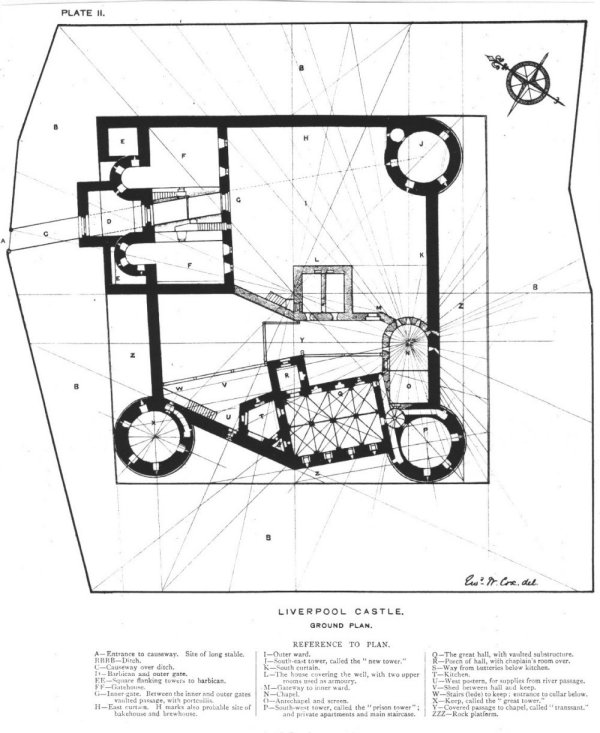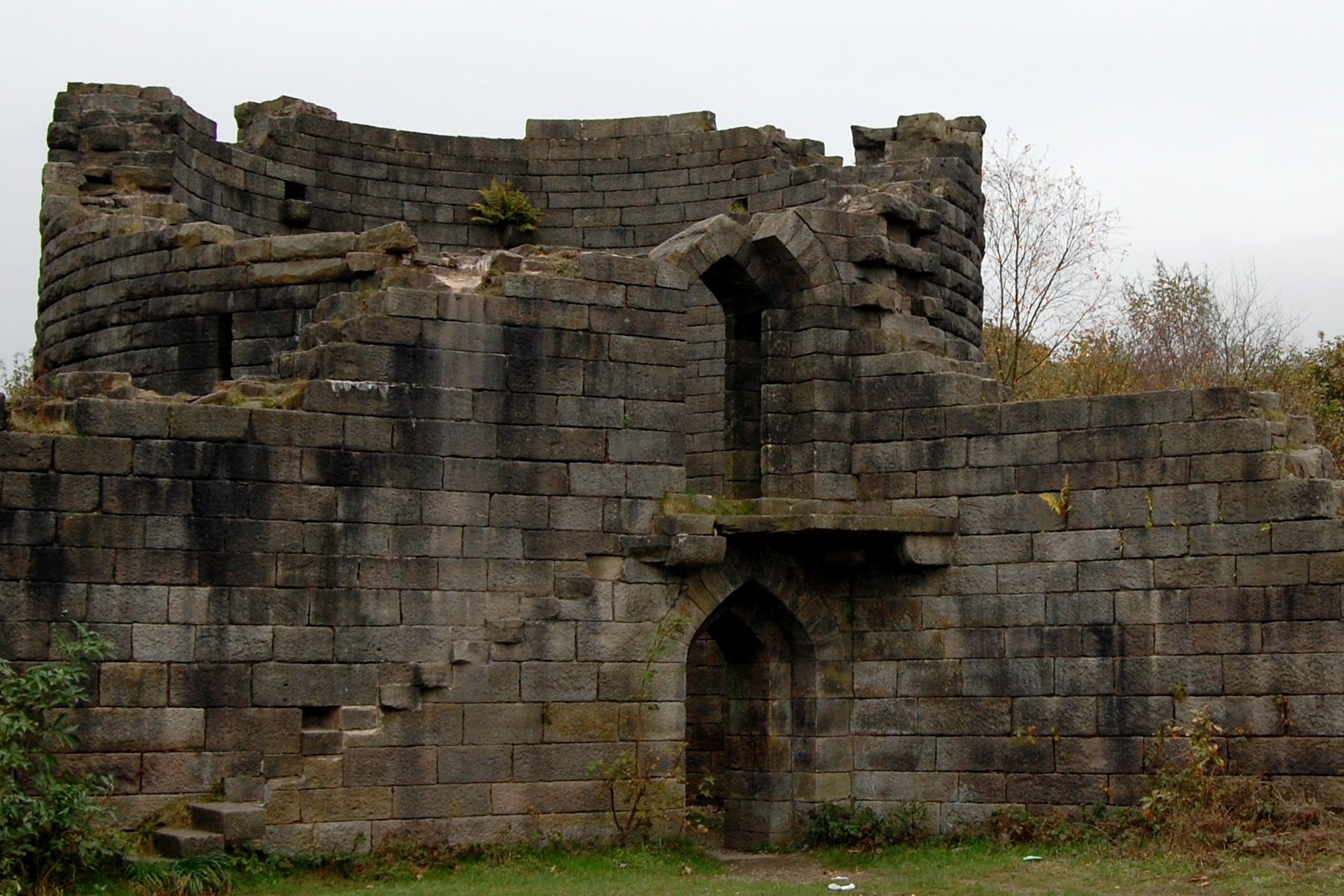Liverpool Castle is one of Liverpool’s greatest lost landmarks, alongside the Customs House and the Sailors’ Home.
The Liverpool corporation pulled down Liverpool Castle itself in 1715 and built St George’s Church in its place. However in 1895 E.W. Cox drew a reconstruction for the Historical Society of Lancashire and Cheshire. In the first decade of the 20th Century the first Viscount Leverhulme built a reconstruction of the ruins of the castle in the village of Rivington near Chorley. Today it stands in Lever Park, a large area of woodland on the east bank of Rivington Reservoir.
Liverpool Castle reconstruction
The replica Liverpool Castle stands on high ground overlooking the reservoir. Though of course it can never quite match the shape of the landscape in medieval Liverpool, the lake acts as a stand-in for the Pool. (Compare this plan on Wikipedia with the satellite view on Google Maps). The position of the River Mersey itself would have been in a west to east direction, on the north side of the two most complete towers at Rivington.
The castle was incomplete by the time of Lord Leverhulme’s death in 1925. Work stopped, though the majority of the intended layout was in place. Today the castle has its fair share of graffiti, and evidence of fires and drinking are all around. However, it’s a great place to go to get a feel for one of Liverpool’s lost gems.










Reconstruction in three dimensions
Here’s a virtual reconstruction of Liverpool Castle using the detailed plans by Cox (see image further down). Ignore the missing…. river, and er… town… and you get an evocative suggestion of what it might have looked like.
A Report on Liverpool Castle
The following information comes from the modern transcription of the Cox report. This is available in the Transactions of the Historic Society of Lancashire and Cheshire, vol 59 (1907): https://www.hslc.org.uk/journal/vol-59-1907/attachment/59-7-gladstone/
‘Utter rwyne’
In June 1559 the castle’s condition was subject to an inspection. A report delivered in October of the same year. Francis Samwell, Ralph Assheton and John Bradill were the commissioners, acting on behalf of Queen Elizabeth I.

Their report gives us a few interesting details about the town of ‘Litherpole’, such as that ‘honeste’ reports from the merchants claim the harbour can hold 300 sails’-worth ships at a time.
Their report did not start well, with reports that the towers and gatehouse were “in utter rwyne [ruin] and decay”. Nearly all the timber and lead had gone (presumably for use elsewhere). In fact, the lead had been missing for longer than living memory.
Rain fell freely through the slateless roof of the biggest tower, which was “a great pytie”. This caused damage to the remaining wood of the floors below. The report hoped that, with repairs, the Queen could once again stay in the castle when she came to inspect the wapentake court at West Derby. Though, considering the independent spirit of Liverpool’s burgeoning council, this might not have been incentive to carry out said repairs.
They also recommended the repair of the curtain wall. This would at least save the blushes of the town, “otherwyse it were a greate defacement”. On a more militant level, the castle was failing to supply its obvious defensive strength to the valuable harbour. This is the very reason it was placed on this promontory, overlooking the Pool.
Defence of the Mersey
However, they acknowledged that no ‘navye’ would be so foolish as to try invasion via the Mersey. The river is dangerous, and Wirral and Wales are nearby, ready to lend a hand in defence!
The commissioners also considered that the castle was good enough (perhaps following their repair suggestions) for the locals to hole up in until reinforcements arrived from the “verie populus” surrounding county.
The commissioners concluded by recommending to the Queen that she offer financial assistance for the repair of the castle. They suggested that £100 should do the trick, allowing for an 11 shilling upkeep each year from then on.
Further reading on Liverpool Castle
These references all relate to what we know of the original castle. (See also Lerpoole 1572 – Historic Liverpool)
Liverpool Castle, The Gatehouse Record, http://www.gatehouse-gazetteer.info/English%20sites/1867.html, accessed 28th September 2019
Liverpool Castle, Heritage Gateway (Historic England), https://www.heritagegateway.org.uk/Gateway/Results_Single.aspx?uid=67505&resourceID=19191, accessed 2nd July 2025
Gladstone Jr, R., 1907, A Report on Liverpool Castle, 2nd October 1559, Transactions of the Historic Society of Lancashire and Cheshire, vol 59, https://www.hslc.org.uk/wp-content/uploads/2017/06/59-7-Gladstone.pdf, accessed 28th September 2019

Alexander Shaw
says:Liverpool castle was not in Liverpool and named as Liverpool castle only because it guarded the reservoirs that fed water to Liverpool. The picture shown above is of the remains of Liverpool castle in Rivington Chorley.